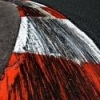The Los Angeles Times of January 23, 1916 writes that "the contract has been let for the paving of the entire mile circle, which was once the world-famous Ascot Park race track [for horses]." The newspapers speaks of a "composition of concrete and asphalt." An article of February 24 states the paving of the course was not completed, but despite this practice for Sunday's races got underway.
The New York Times of July 16, 1916 mentions that...
"[...] Ascot Speedway is the only one of its kind in the world. Having been converted from the old horse race course of that name. This was done by eight weeks of rushed construction work last winter. The turns were banked to a height of eleven feet, and then the entire course was paved. Because the 'greenness' of this paving last winter ate up tires, But George R. Bentel, Chairman of the Contest Committee at Ascot, this Fall will resurface the track. In addition to the smoothing of the track surfacing, large bleachers are to be erected because of the immense popularity with which the racing has been received in this section. Ascot is the widest course of its kind, also the fastest, and its popularity has been heightened by the fact that the cars are in sight all the time."
Was this track really paved with concrete and/or asphalt in 1916 ? Board tracks aside, I think this would make Ascot the fourth paved track in America, after Indianapolis Motor Speedway (late 1909, bricks), Twin City Motor Speedway (September 1915, concrete) and Narragansett Park Speedway (September 1915, asphalt).
The reason I ask is because some sources still refer to the track as dirt after 1916. Can anyone offer more from period sources ?












